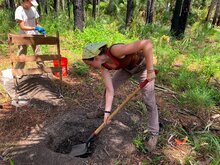Much of our field school was spent digging shovel test units and the proper way to dig these units. We focused heavily on the correct technique to cut walls with shovels to ensure the walls would not collapse and there would be a sturdy structure to continue digging down, as some shovel test units could be dug a meter deep. It also is significant to ensure that no artifacts are missed by cutting the walls to be less than the assigned shovel test unit size. However, these walls are not just important for the structural integrity of the unit or artifact collection, there are also significant for understanding stratigraphy across different levels.
Straight, uniform walls are key in being able to view the different layers of soil and where they change, which helps to understand the soil content of the area. It also helps to differentiate where the sterile layer, or where no artifacts are found, starts. This can be seen in soil color changes, as a layer without any artifacts or natural decomposition will be lighter in color, because it does not have nutrients from decomposition. If the wall is not straight, this can affect the start of different soil layers, and can be inconsistent across the height of the wall. This can create differing interpretations of where soil layers start and end across units, creating inconsistent data within the project. Learning to cut straight, clean walls with the shovel is crucial to digging successful shovel test units.
